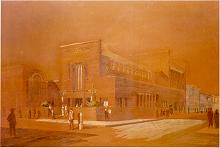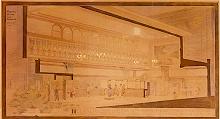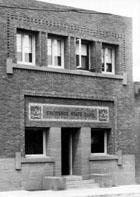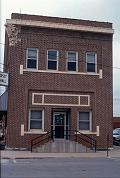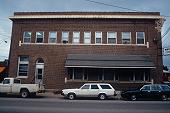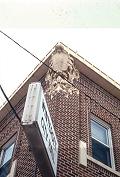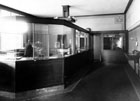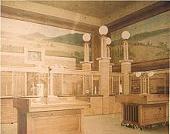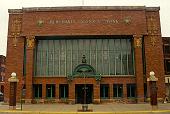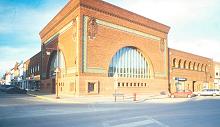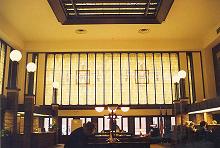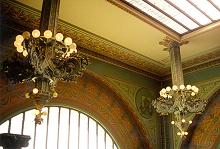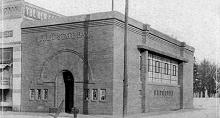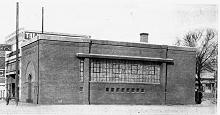 |
firm active: 1907-1921 minneapolis, minnesota :: chicago, illinois |
Ye Older Grindstones
7/23/2002
The Matter of the Purloined Banks, with Contemplation of Star Wars as a Parable in American Architecture
Added links for First National Bank project (the one plagiarized by Thomas Ellerbe, who thus stole the commission according to the editorial in The Western Architect; see notes following) and the Elk's Club project, both in Mankato, Minnesota; and the Harry Page residence in Mason City.
First National Bank, project
Mankato, Minnesota 1911
Presentation rendering
First National Bank, project
Mankato, Minnesota 1911
Transverse sectionAll of which leads me to ponder the two times in documentation to hand that other architects availed themselves of not just ideas out of Purcell and Elmslie, but the very drawings out of their hands. Is it surprising that both buildings were banks? If you look through Purcell's Parabiographies entry for this project, you see he is trying to put as polite a face on it as possible, referring to Ellerbe as an architectural practice doing "hack work." Ah, well, it's his drift, what can you do? Then he refers to P&E's several (3) fully rendered concepts as a bit preciously self-conscious expressions of beauty. Intimating, as WGP does here in his oft times sly wit, that the Lone Cashier, despite a proper education by Mssrs. Purcell and Elmslie in the value of an organic architecture, was too blind with lower desires to perceive the higher possibilities of the genuine article. Alas.
The Rip-off by Ellerbe
Of course, they had started out with an unspoken understanding that gentlemen were sitting all around the table. The fellow asks to keep the P&E drawings for further consideration, and he is obliged. Some long weeks later, the drawings are returned with a rejection slip. Ellerbe then builds a tin cornice-less, terra-cotta bearing, and leaded glass panel-lit rectangular mass for which the professional world thereabouts congratulates by Purcell and Elmslie. Out, out, damned clerestory!
I am told these things happen in the architectural "business." In great ways or small, someone is always a potential hacker. Sometimes, as with the Mankato bank, it can be a puffed-up head cashier who fancies himself a judge of what works. He called in the hatchet man. Shifty. This man was in a position of fiscal authority in this rural Minnesota town. We have no evidence as to why his attraction toward Ellerbe. We can only speculate it was probably one of the usual things that happen: a relative, a friend or college classmate, a business association, something that had the desire for a relationship to flourish between the bank and Ellerbe. But in the end we don't really know.
Exchange State Bank
Purcell, Feick and Elmslie
Grand Meadow, Minnesota 1910
(now) Winterset City Hall
Unknown copyist
Winterset, Iowa post-1910!
Photograph courtesy Richard Kronick
Side elevation
Side elevation
Photograph courtesy Richard KronickThe other bank building is pretty much straightforward. Located in Iowa, this small town bank is a literal transcription of the Exchange State Bank in Grand Meadow, Minnesota. Dick Kronick told me about this copy of the building, and the images here are from his gracious hand. No attempt to build with silk and silver thread. Just a nice off-the-rack all-weather cloak that substitutes simple brickwork for the terra-cotta ornament from Elmslie's hand in Grand Meadow. Instead, the Home Depot version of a great carbuncle added on the corner, tucked up beneath a TIN cornice. As you can tell, whoever stole this design was wholly clueless about the intention and meaning of the original enrichment.
Photograph courtesy Richard KronickThe P&E original is a great concept for a small bank building that supports itself with office space to lease on the second floor. Located above the banking room, it is the most prestigious commercial space in the vicinity and therefore highly desirable. Even has a decorated entrance for prominent street access. There is no shared lobby, so the banking room is more secure. Remember, there are in fact bank robbers out in the countryside, running from small town to smaller town with a fast cars and quick pistols.
Exchange State Bank
Banking room, 1910
Merchants National Bank
Winona, Minnesota 1912
Original banking room, 1914
Autochrome Lumiere transparencyThat makes the question of the "teller cage" come up. P&E tried wherever possible to get their banker clients to leave out the grille between customer and cashier. In this they often failed most magnificently, as in the Merchants National Bank in Winona, Minnesota. The openness of the banking space, structured with the pier-and-lintel version of what at the National Farmers' Bank authored by George Grant Elmslie in Sullivan's name earlier in 1905 turned out to be an arch, was an exaltation.
Merchants National Bank
Purcell, Feick and Elmslie
Winona, Minnesota 1912
National Farmers' Bank
Louis H. Sullivan and George Grant Elmslie, architects
Owatonna, Minnesota 1905
Photograph courtesy of Bill HuegAt Winona, Elmslie also opened up two vast walls of leaded glass. In the afternoon, even in the present damaged state of the banking room [a whole wall is missing, among other things], there is a celestial quality to the interior light. The skylight is still a ceiling of heavenly delight, albeit one reconstituted with more modern glass following decades of rot through neglect. At Owatonna, the banking room is a cherished and restored public monument, as it was always intended to be by client Carl K. Bennett. Much of the surface above the height of the human occupants is vibrantly intact. Lucky Minnesota.
Merchants National Bank
Purcell, Feick and Elmslie
Winona, Minnesota 1912
National Farmers' Bank
Louis H. Sullivan and George Grant Elmslie, architects
Owatonna, Minnesota 1905
Photograph courtesy of Bill HuegThe bank spaces in the Middle West are essential community places-in-common. Shared ground, open to all while housing the functions of an above-board, well-principled democratic economic relationship. And the two greatest ones, in my view of the playing field, were authored by George Grant Elmslie. Then there was the perfect reduction to essentials, sometimes all the way down to the baseline minimal profile, in the other small town banks P&E did. The First State Bank at Leroy, Minnesota is as lean a structure as they achieved. For $10,000, turnkey. No terracotta. No leaded glass panel enrichments. No custom anything. Just right out of the box, your new and improved box, the better mousetrap because it is thought through. Saved you some money on unnecessary Greek columns! And it works beautifully, even now.
First State Bank
Leroy, Minnesota 1914
Side elevationThat reminds me of a theme park designer at Disney I knew once. He told me that one memorable moment was being at Disneyland, along the Rivers of America. He was just hanging around, and noticed an original "effect" still at work, undisturbed, ever since the park was built. Effects, among other things, are little mechanisms whose motions lend predictable verisimilitude to an artificial environment like Frontierland. They are little gestures, or salutes, to assure the expecting eye or ear that the idea of a thing is properly considered to be present. In this case, the thing was a little water-powered fake fish or duck, I forget which he said, twirling contentedly every few moments through its lifecycle. Blurp <pause> Blurp <pause> Blurp.
Harken! The Rivers of America are abundant with fish and fowl, sail down them to your Manifest Destiny. The effect is talking to your mind by way of your senses. It is representing the existence of the idea as an actual presence. Your mind does not necessarily alert you to a fraud in progress, but passes along the intent of the design with a rubber stamp. Your body reacts as if the effect is real, because the moment is designed to occur that way. In this case, as the Mark Twain Steamboat shushes by, feel young and adventurous. You are entrained with the pattern, and will now go climb in the [oh yes, the real] Swiss Family Robinson Treehouse. All that punctuated by a splashing plop that sort of, at a distance, looks like a fish or perhaps a duck. See quickly or it is gone. True as well about the finer expressions of the same thing we term collectively as architecture.
My James Burke-esque digression does have relevance to the Matter of the Purloined Banks. The "effect," that psychological assurance of things-as-they-should-be, in P&E structures is in the design itself, not in the presence of polychrome terra-cotta or sawed wood panels. Ellerbe coerced his faux-pas project forward with the terra-cotta company [research indicates this was NOT an ATC job; W. D. Gates would not do such a thing, would he?] and other vendors, by their fear of blacklisting on future business. He contracted out for ripped-off light fixtures and all the rest, but in the final act he could not do more than copy what he was shown within his view of a budget. Yeah, sure, we'll get some of that shiny terra-cotta stuff, and throw in a few nice check desks. But that notion of opening that space with extra glazing, no sir. This is the secular lockbox of Democracy, and therefore sliver that plane of glass, sever the continuity, buttress-up, pier out! Bah, humbug on that clerestory lighting! None of those pesky engineering problems, either. Of our two thieves, which missed more greatly missed the point?
The result in any event is architectural stillbirth. The Ellerbe design sits now in a quiet and mostly vacant section of old downtown Mankato. Last time I was there the building seemed to be serving as a lawyer's office. The sense of the place is sorrowful, as if lamenting that what is rhinestone might have been a real jewel. The door is locked. Contrast that with the effect of being in the banking rooms in Owatonna, Winona, and even little Leroy. They still live and breathe, they are still valuable places of exchange and community. Even if someone did chisel down the name of the long since defunct Exchange State Bank in Grand Meadow from the terra-cotta cartouches on the side of the building. Chip off those delicate whisps of the modeler's art, banish Elmslie's deft alphabetic line! "Da bank done went boom," as Jar Jar Binks might say. "Bust," corrects Obi-Wan. "The expression is 'bust.'"
Don't tell me no one else ever thought of the Star Wars parable. Carter Manny took me and Tim Samuelson to lunch in the spring of 1984 at an Italian restaurant not far from the Graham Foundation house. Wanting to offer something to the company, I noted that there was a mythological parallel between the history of organic architecture in America and the characters in Star Wars. Among the obvious correlations:
- Yoda = Louis Sullivan
- Obi-Wan Kenobe = George Grant Elmslie
- Luke Skywalker = William Gray Purcell
- Darth Vader = Frank Lloyd Wright (black cape and all)
Yes, the list goes on with the Griffins, and so on. But at that pleasant table over a good salad with feta and warm bread, it made for an amusing moment. Carter Manny suggested I write it down as an article; here anyway at long last for whatever chuckle you can get. And with that, I am off to some contemplative time before waging war again tomorrow on the web site work that keeps this server serving. For how much longer, in these desperate times, I do not know...
